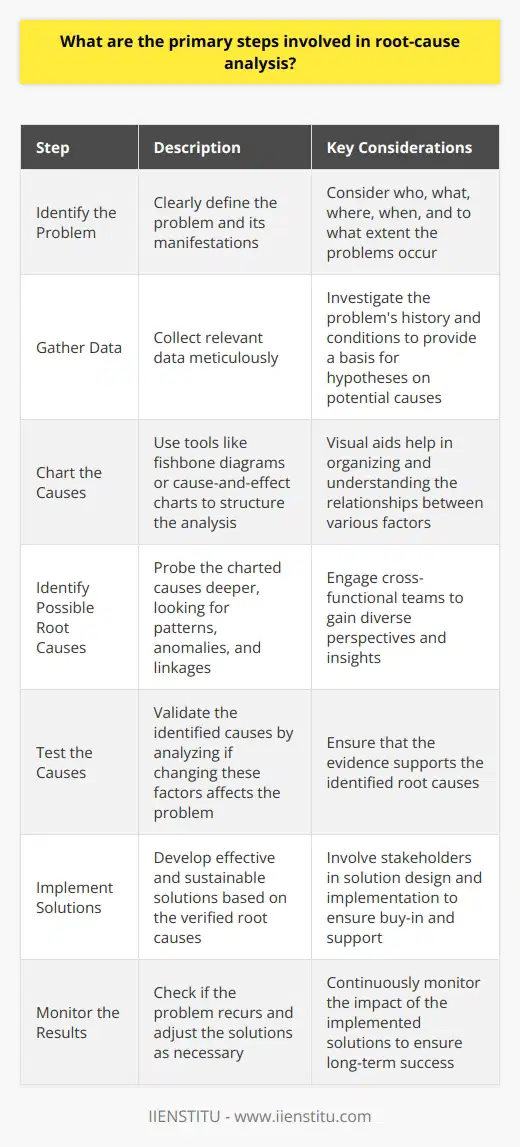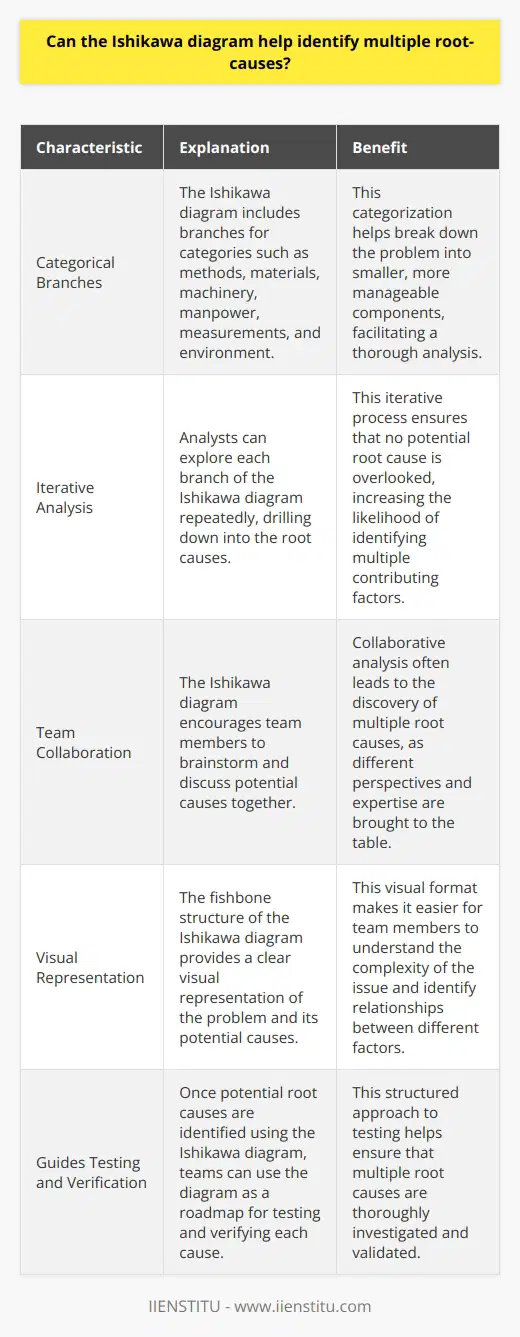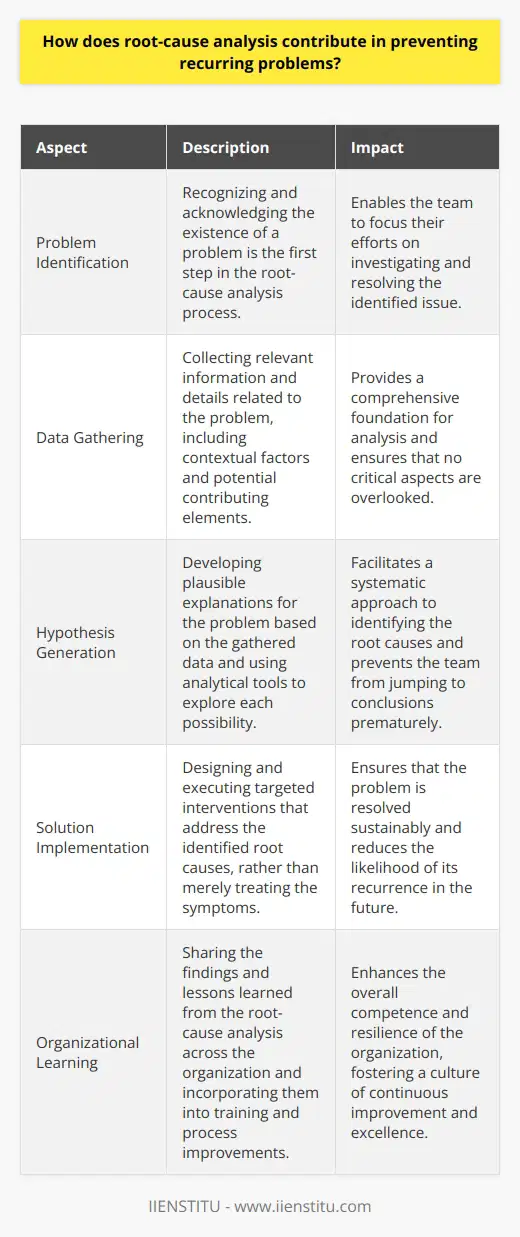
Root-cause analysis is a powerful investigative methodology used for problem-solving that works by identifying the core issues causing symptoms of a larger problem in operational processes or business systems. This approach delves deeper into understanding why a problem occurred in the first place, rather than simply addressing the immediate issues. By targeting the root, one can implement strategies that lead to more sustainable and effective solutions. Serious commitment is required when applying root-cause analysis: the process is often intricate, necessitating critical thinking and meticulous attention to detail. When executed successfully, it can lead to significant business improvements.
I remember when I first learned about root-cause analysis during my undergraduate studies in business management. Our professor, Dr. Smith, was an enthusiastic advocate for this approach. He would often share stories from his consulting days, where he helped companies unravel complex problems using root-cause analysis. One particular story stuck with me: a manufacturing company was facing recurring quality issues with their products. Instead of just fixing the defective items, Dr. Smith guided them through a root-cause analysis. They discovered that the real problem was in their supplier's raw materials. By addressing this root cause, they not only solved the quality issue but also strengthened their supply chain. This example showcased the power of root-cause analysis in driving lasting improvements.
The importance of root-cause analysis for business improvement cannot be overstated. In the dynamic landscape of modern business, companies need to swiftly adapt to change and resolve inefficiencies to stay competitive. Effective problem-solving, therefore, becomes not just an operational necessity but a strategic advantage. Root-cause analysis serves as a fundamental tool in identifying not just what went wrong, but why it went wrong, allowing businesses to create strategic plans to prevent future occurrences. This proactive stance is essential for continuous improvement and maintaining high standards of performance across all business facets.
Peter Drucker, the renowned management thinker, emphasized the significance of getting to the heart of problems in his book "The Effective Executive." He noted, "The effective executive does not start out with the question, 'What do I want to do?' He starts out asking, 'What needs to be done?'" (Drucker, 1967, p. 24). This mindset aligns perfectly with the root-cause analysis approach, which focuses on understanding and addressing the fundamental needs of a system.
This blog aims to enlighten readers on the powerful impact of root-cause analysis in achieving profound business improvement. The content will guide readers through the principles and strategies of root-cause analysis, illustrating its utility in process analysis and risk management, and demonstrating its application through varied examples and case studies. Whether you're a seasoned manager, an aspiring student engaged in a business program, or a professional seeking an edge in problem-solving, this information will enhance your toolkit for tackling complex challenges within any organizational framework.
At the very heart of root-cause analysis lie its core principles: identifying and resolving the primary cause of a problem to prevent its recurrence. It is a structured approach that involves a series of steps such as:
1- Problem identification
2- Data collection
3- Causal factor charting
4- Root-cause identification
5- Solution implementation
The method relies on logic, data, and research rather than assumptions and quick fixes. Effective root-cause analysis, therefore, demands a blend of intuitive reasoning and empirical evidence, with a focus on long-term outcomes rather than temporary relief.
In his book "The Toyota Way," Jeffrey Liker discusses Toyota's "5 Whys" technique, a classic root-cause analysis tool. He explains, "By repeating why five times, the nature of the problem as well as its solution becomes clear" (Liker, 2004, p. 252). This simple yet powerful approach underscores the importance of persistent questioning in getting to the bottom of issues.
In the context of process analysis, root-cause analysis seeks to unravel complexities to improve operational efficiency, quality control, and productivity. Through diligent exploration of the root causes, organizations can streamline processes and optimize performance. In risk management, meanwhile, root-cause analysis supports the identification of underlying threats and vulnerabilities, allowing for the establishment of robust controls and preventive measures. This proactive risk management ensures steady progress and safeguards the business's interests.
The initial stage of root-cause analysis is to gather accurate and comprehensive data concerning the problem at hand. Without reliable data, the ensuing analysis is built on shaky premises, likely leading to misguided conclusions. Data collection may involve quantitative methods, such as statistical measurements, or qualitative methods like interviews, surveys, and observations. The key is to obtain a holistic view of the problematic scenario to aid in the precise identification of the issue.
In "The Signal and the Noise," Nate Silver emphasizes the importance of quality data. He writes, "The numbers have no way of speaking for themselves. We speak for them. We imbue them with meaning" (Silver, 2012, p. 9). This insight highlights the critical role of the analyst in interpreting data correctly for effective problem identification.
Investigative techniques form an integral part of problem identification. Methods such as the 5 Whys, fishbone diagrams, and failure mode and effect analysis (FMEA) enable analysts to delve deep into causal relationships and uncover potential root causes. A disciplined approach to investigation rejects subjectivity, focusing instead on the systematic uncovering of facts and links that govern the dynamics of the problem.
Visualizing the problem is an effective strategy for mapping out cause-and-effect. Tools such as flowcharts, fishbone (Ishikawa) diagrams, and mind maps allow for a graphical representation that clarifies the interconnections between various factors. Using visual tools can make complex relationships easier to understand and communicate, paving the way for a more robust root-cause analysis.
Edward Tufte, a pioneer in information design, stresses the power of visual representations in his book "The Visual Display of Quantitative Information." He asserts, "Excellence in statistical graphics consists of complex ideas communicated with clarity, precision, and efficiency" (Tufte, 2001, p. 13). Applying this principle to root-cause analysis, visual tools can greatly enhance the clarity and impact of the findings.
A key challenge in root-cause analysis is discerning symptoms from actual causes. Symptoms can often mislead analysts, as they are the evident manifestations of deeper issues. An expert approach to root-cause analysis ensures that symptoms are acknowledged but not mistaken for the real issues that warrant resolution. Recognizing this distinction is crucial to guarantee that the actual root causes are addressed.
Once potential causes have been laid out, isolating the root cause is the subsequent step. Techniques such as the Pareto analysis can help prioritize issues based on their significance. The use of these techniques should lead to the identification of the fundamental cause which, when addressed, would yield the most significant improvement.
In "The 80/20 Principle," Richard Koch explains the Pareto Principle, stating, "A minority of causes, inputs, or effort usually lead to a majority of the results, outputs, or rewards" (Koch, 1999, p. 4). Applying this concept to root-cause analysis, it suggests that a few key causes often account for the majority of problems, and identifying these should be the focus.
There are several common pitfalls in identifying root causes, such as:
Confirmation bias
Focusing on a single cause when there may be multiple
Underestimating the complexity of cause-and-effect relationships
Skilled practitioners of root-cause analysis are vigilant against such pitfalls, ensuring that their analyses are as comprehensive and unbiased as possible.
After surfacing the root cause, the next critical phase is solution development. Effective solutions are those that are actionable, sustainable, and aligned with the organization's goals. They should be vetted against criteria such as cost, feasibility, impact, and alignment with organizational strategies. This ensures that the solutions not only address the problem at hand but also contribute to the company's overarching objectives.
Peter Senge, in his seminal work "The Fifth Discipline," underscores the importance of systemic thinking in problem-solving. He writes, "The key to seeing reality systemically is seeing circles of influence rather than straight lines" (Senge, 2006, p. 75). This perspective is vital in developing solutions that consider the interconnectedness of factors within a system.
While developing solutions, it is important to consider both their short-term and long-term impacts. Quick fixes may appear appealing, but unless they lead to sustainable change, the problem is likely to recur. Effective solutions should thus be designed with an awareness of their longevity and continued relevance.
Effective implementation of solutions identified through root-cause analysis involves careful planning, clear communication, and proper resource allocation. The implementation process must be systematic and monitored closely. For instance, a pilot test may be conducted to gauge the solution's efficacy before it is rolled out fully.
John Kotter, a leading expert on change management, outlines an eight-step process for implementing change in his book "Leading Change." He emphasizes the importance of creating a sense of urgency, forming a guiding coalition, and anchoring new approaches in the culture (Kotter, 1996). These principles can be applied to the implementation of solutions derived from root-cause analysis to ensure their success.
Establishing metrics and key performance indicators is crucial for monitoring the effectiveness of implemented solutions. Regular checks, feedback loops, and performance reviews help in evaluating progress and making necessary adjustments. These practices ensure that the solutions have a transformative impact on the problem and contribute to ongoing process improvements.
Real-world business improvement scenarios demonstrate the successful application of root-cause analysis. For example, a manufacturing company that experienced recurring machinery failure might use root-cause analysis to uncover inadequate maintenance procedures, leading to improved practices and reduced downtime.
In his book "The Goal," Eliyahu Goldratt presents a fictional account of a plant manager who uses root-cause analysis to identify and eliminate bottlenecks in his production process. The story illustrates how identifying and addressing core constraints can dramatically improve operational performance (Goldratt & Cox, 2004).
Not all attempts at root-cause analysis yield success. There are lessons to be learned from failed analyses, such as the importance of comprehensive data collection, correct interpretation of data, and carrying out adequate tests. Evaluating such failures can provide crucial insights into refining the root-cause analysis approach.
Embedding root-cause analysis within the risk management process of an organization ensures that risks are not just mitigated on the surface but are reduced at their core. Such integration can preempt disruptions and secure the company's assets by building resilience into its operational fabric.
The success of root-cause analysis often hinges on the cultural context within a business. Cultivating an environment that values critical thinking, transparency, and continuous improvement is critical. In organizations where root-cause analysis is embraced as a norm rather than an exception, the processes are more robust, and improvements more sustainable.
Edgar Schein, a pioneer in organizational culture, emphasizes the role of leadership in shaping culture in his book "Organizational Culture and Leadership." He states, "The only thing of real importance that leaders do is to create and manage culture" (Schein, 2004, p. 11). By fostering a culture that values root-cause analysis, leaders can drive lasting change.
The journey of root-cause analysis is one of continual learning. Incorporating the lessons learned from each instance of root-cause analysis ensures that the organization not only resolves current problems but becomes adept at preventing future ones. This loop of continuous improvement is the hallmark of a proactive and resilient organization.
Embedding root-cause analysis into the fabric of everyday business practices empowers employees to tackle challenges systematically. It becomes a fundamental part of the organization's approach to project management, operations, and strategic planning, leading to higher quality, efficiency, and customer satisfaction.
To recapitulate, root-cause analysis is an indispensable tool in diagnosing deep-seated problems and forging effective solutions. By addressing problems at their source, organizations position themselves to make lasting improvements.
I encourage businesses, teams, and individuals to incorporate root-cause analysis into their problem-solving toolkit. Embracing this approach leads to clearer understanding, better decision-making, and enhanced performance.
Root-cause analysis is more than a technique--it's a philosophy of proactive improvement. When deployed effectively, it elevates the quality and resilience of business processes, positioning organizations to thrive in an ever-evolving marketplace.
References:
Drucker, P. F. (1967). The effective executive. HarperCollins.
Goldratt, E. M., & Cox, J. (2004). The goal: A process of ongoing improvement (3rd ed.). North River Press.
Koch, R. (1999). The 80/20 principle: The secret to achieving more with less. Currency.
Kotter, J. P. (1996). Leading change. Harvard Business School Press.
Liker, J. K. (2004). The Toyota way: 14 management principles from the world's greatest manufacturer. McGraw-Hill.
Schein, E. H. (2004). Organizational culture and leadership (3rd ed.). Jossey-Bass.
Senge, P. M. (2006). The fifth discipline: The art and practice of the learning organization (Rev. ed.). Currency/Doubleday.
Silver, N. (2012). The signal and the noise: Why so many predictions fail--but some don't. Penguin Press.
Tufte, E. R. (2001). The visual display of quantitative information (2nd ed.). Graphics Press.
Frequently Asked Questions
What are the primary steps involved in root-cause analysis?
Root-cause analysis (RCA) remains a fundamental method for problem-solving. It seeks to identify the underlying reasons for problems. This approach aims to prevent recurrence by addressing these root causes. The primary steps involved in RCA are straightforward, although they require careful implementation.
Identify the Problem
At the outset, clearly define the problem. Ensure you understand its manifestations. Consider who, what, where, when, and to what extent these problems occur. Detailing the problem sets the stage for a thorough analysis.
Gather Data
Data collection follows problem identification. Collect relevant data meticulously. Investigate the problem's history and conditions. This step provides a basis for hypotheses on potential causes.
Chart the Causes
Once data is at hand, charting the causes begins. Use tools like fishbone diagrams or cause-and-effect charts. Such visuals aid in structuring analysis.
Identify Possible Root Causes
Probe the charted causes deeper. Look for patterns, anomalies, and linkages. Engage cross-functional teams for diverse perspectives. This process will unearth the potential root causes.
Test the Causes
Validity is key; thus, test the identified causes. Does the evidence support them? Analyze if changing these factors affects the problem.
Implement Solutions
Upon verifying the root causes, develop solutions. Solutions should be effective and sustainable. Involve stakeholders in solution design and implementation.
Monitor the Results
Once solutions are in place, monitor their impact. Check if the problem recurs. Adjust the solutions as necessary to ensure long-term success.
This evidence-based approach offers a systematic method to tackle complex problems. RCA provides a framework for deeper understanding and lasting solutions. It emphasizes not just temporary fixes but structural changes that prevent recurrence. In applying the RCA steps, teams learn and evolve, which fosters a proactive problem-solving culture.

Can the Ishikawa diagram help identify multiple root-causes?
The Ishikawa Diagram
The Ishikawa diagram, also known as the fishbone diagram, serves as a tool for root-cause analysis. Originated by Kaoru Ishikawa, it aids in systematic problem exploration. This visual representation dissects issues into deeper contributing factors. Typically, it focuses on various potential origins of problems.
Multiple Root-Causes Examination
Can the Ishikawa diagram uncover numerous root-causes? Absolutely. The diagram's structure supports multifaceted cause identification. Its design encourages critical thinking. Users scrutinize more than one possible reason for a problem.
Key Components
The Ishikawa diagram possesses branches for categorical factors. These often include:
- Methods
- Materials
- Machinery
- Manpower
- Measurements
- Environment
Each category branches out further into specific factors.
Delving into Complexity
For complex problems, several root-causes often exist. The Ishikawa diagram excels at handling this intricacy. By breaking down categories, it exposes myriad potential culprits. Analysts then examine specific branches to pinpoint multiple root-causes.
Encouraging Team Analysis
The Ishikawa diagram facilitates team collaboration. Teams can brainstorm and debate causes together. This dialogue often reveals multiple root-causes. The collective scrutiny enhances thoroughness.
Iterative Analysis
Analysts might need to drill down iteratively. They can explore each branch repeatedly. This process ensures no stone goes unturned. As a result, they often uncover several root-causes.
Overcoming Oversimplification
The Ishikawa diagram prevents oversimplified analyses. Simple answers rarely suffice for complex problems. By examining various factors, the diagram helps avoid such oversimplifications.
Supporting Testing and Verification
Following identification, teams test each potential root-cause. The Ishikawa diagram provides a clear roadmap for this testing. It guides analysts in verifying multiple root-causes.
The Ishikawa Advantage
In conclusion, the Ishikawa diagram indeed assists in identifying multiple root-causes. Through rigorous, team-based, and iterative analysis, it surfaces intricate issue networks. Consequently, it stands as an invaluable tool in the arsenal of problem-solving techniques.

How does root-cause analysis contribute in preventing recurring problems?
Root-Cause Analysis: A Critical Tool for Problem Prevention
Root-cause analysis (RCA) stands at the heart of problem-solving. It goes beyond treating symptoms. Instead, it seeks to unearth underlying issues. RCA helps uncover reasons why problems emerge. Through detailed investigation, it identifies contributing factors. These can range from human errors to systemic failures.
Fundamentals of Root-Cause Analysis
RCA employs specific steps to discern root causes. Initially, it begins with problem identification. Once recognized, a problem becomes the subject of in-depth inquiry. Team members then gather data, meticulously documenting all relevant details. This stage is crucial as it sets the stage for analysis.
Analysis involves hypotheses about potential causes. Each possibility undergoes rigorous exploration. Team members leverage tools like fishbone diagrams or the 5 Whys technique. These methods encourage persistent inquiry. Techniques like these dissect complex situations efficiently. They maintain focus on causative elements, not just symptoms.
Once root causes receive proper identification, they can be addressed. Solutions target the very epicenter of the issue. Such precision prevents superficial fixes. It ensures sustainable problem resolution. The solutions exhibit a bespoke fit to the problem at hand.
The Role of RCA in Preventing Recurring Problems
- Identification of patterns: RCA spots recurring issues.
- Systemic change: Solutions address fundamental systems, not just outcomes.
- Knowledge transfer: Teams learn from findings and adapt processes.
- Continuous improvement: RCA fosters a proactive culture of refinement.
- Data-driven decisions: Empirical evidence guides response strategies.
These elements fuel a cycle of learning and improvement. They form the bedrock of preventive action. In essence, RCA transforms problem-solving. It ensures a shift from reactive to proactive approaches. This proactive stance anticipates potential failures. It takes measures to avoid their occurrence.
The Ripple Effect of Effective Root-Cause Analysis
The impact of RCA resonates across an organization. Employees grow aware of the importance of accuracy. They understand that blame is less helpful than solutions. As RCA informs policy, processes evolve. They become more robust, resilient to future challenges. This evolution embodies the principles of quality management.
Furthermore, RCA highlights areas for staff training. It pinpoints gaps in skills or knowledge. Training tailored to these findings enhances operational competence. Competent operations reduce the likelihood of repeat problems. They underpin a culture of excellence.
In conclusion, RCA stands not as an isolated exercise but a strategic imperative. It frames a mindset that favors depth over haste. It accelerates organizational learning. It weaves a fabric of prevention into the operations of an enterprise. Through diligent application of RCA, organizations move towards a state where problems are rare, and smooth operations are the norm.



